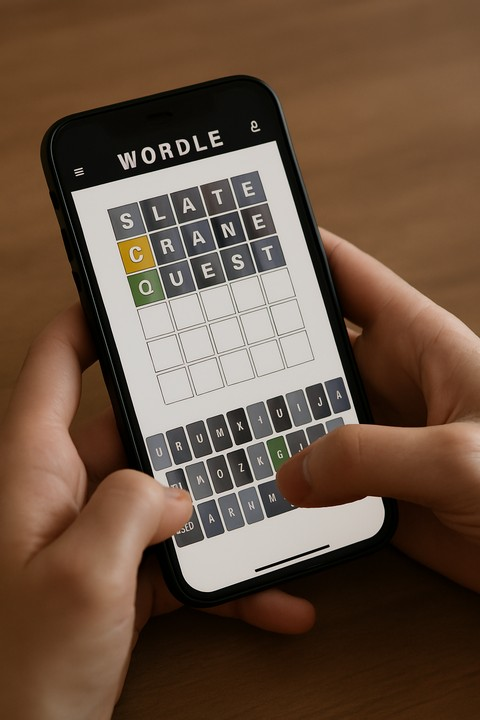Wordle Master Strategy: The Complete 3-Step Breakdown
Think Wordle is just a casual guessing game? Wrong.
True masters treat Wordle as a battlefield of linguistic logic—solving puzzles within six steps, compressing information density in just three, and packing deduction, elimination, strategy, and cold-blooded calculation behind every letter.
This article breaks down the actual thinking structure of Wordle pros—no gut feeling, no luck—just word bank building, rule filtering, and tactical probing. Limited steps, infinite possibilities.

Step 1: High-Information Opener
Not Random Guessing, But Tactical Scanning
Real players don’t start with cute but clueless words like apple. They go for:
slate / crate / react / adieu / table
These words share three traits:
- Cover high-frequency vowels (A, E, I, O, U)
- Include common consonants (S, T, R, N, L)
- Avoid repeating letters (maximum information gain)
One goal: Squeeze as much feedback as possible from a single guess.
Wordle isn’t door-kicking luck—it’s throwing sonar and slicing through feedback.
Casuals: Play by vibes.
Pros: Play by letter frequency + layout efficiency = Information radar.
Step 2: Reverse Engineering + Word Pattern Modeling
Once feedback is in, pros don’t just count greens. They initiate:
- Elimination (gray letters: shrink the candidate pool)
- Repositioning (yellow letters: rotate possible slots)
- Template modeling (green letters: anchor the word mold)
Mental image:
[ ] [A] [ ] [E] [ ]
A is green in position 2, E can’t be in slot 4.
Not aesthetic—this is code scanning. Filter every known word mentally by grid coordinates. Keep matches. Trash the rest.
This is the gate between average play and elite compression.
Step 3: Tactical Probe
Intentionally Writing "Wrong Words" to Expose Truth
Here lies the real divide.
Casuals: Chase the answer.
Pros: Use bait words like dough not to solve, but to test:
- Is there an O, U, G, or H?
- Which positions are possibly valid?
Tactical probe words = Not for the win. For the kill next move.
Give up "answer hunger" to gain control over solution pathways.
Wordle’s Hidden Depths: Frequency, Roots, Structures
On the surface, Wordle looks like a vocabulary game.
Underneath: dictionary compression and pattern recognition.
Pros:
- Memorize ~2300 common 5-letter words
- Spot repeated-letter traps (bloop, boost, knoll, llama)
- Develop letter combo reflexes (TR-, CH-, -CK, -ND)
They build a mental radar:
"Looks right. Looks off. Worth probing. Pass."
Some play Wordle to pass time.
Pros use it to train model-thinking.
How Hardcore Players Play
(Not Advice. Warning.)
Think the pros make it look easy? Not really.
They:
- Track daily solution letter frequencies
- Write scripts simulating guess paths
- Curate personal word lists and combos
- Create optimal-start decision trees
This isn’t Wordle.
It’s Go + war games + programming logic.
Bonus Module: Wordle Master Training Camp
Can you lock the answer by Step 3?
Feedback:
- SLATE → A is yellow, E is green
- ROUND → All gray
- ??? → Your move
Objective:
- Shrink down to 2 candidate words or less with guess #3.
- Eliminate: R, O, U, N, D
- Keep: A exists (not in position 2), E confirmed in position 4
Submit your thought process—then compare with master solutions.
Reference List: Top 10 High-Information Opener Words
- SLATE
- CRANE
- TRACE
- AUDIO
- RAISE
- SLANT
- REACT
- SALET
- STARE
- TABLE
Rotate your starters—don’t tunnel vision.
Trap Alerts: Top 5 Repeat-Letter Pitfalls
BOOST (double O)
BLOOP (double O)
KNOLL (double L)
LLAMA (double L)
KAYAK (symmetric structure distraction)
Closing Thoughts: You’re Not Guessing Words—You’re Deconstructing Feedback Systems
Real Wordle masters never rely on vibes.
They rely on control, deduction, and linguistic pressure tactics.
You can play for fun.
Or turn Wordle into a cognitive training ground.
Every word you write tests whether the system still respects logic.
Next time you open Wordle, try this:
- Start with a high-density opener
- Format your word mold and filter logically
- Drop a tactical probe to expose the core
Then—see if you can kill a puzzle in 3 moves.